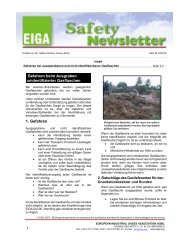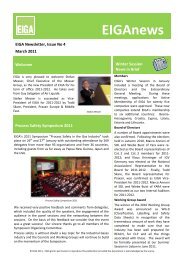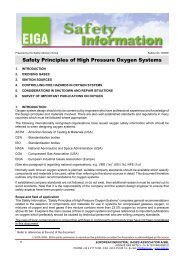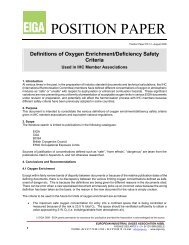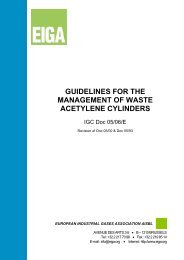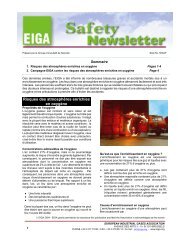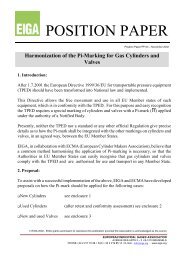CODE OF PRACTICE DRY ICE - eiga
CODE OF PRACTICE DRY ICE - eiga
CODE OF PRACTICE DRY ICE - eiga
Create successful ePaper yourself
Turn your PDF publications into a flip-book with our unique Google optimized e-Paper software.
IGC DOC 150/08<br />
Dry ice containers shall be constructed of easily cleanable and maintainable materials e.g. stainless<br />
steel, fibreglass and epoxy, plastic or non-ferrous alloys. The use of disposable plastic container liners<br />
should be considered, especially for "loose" product, which has no primary wrapping.<br />
Containers (full or empty) should be kept closed, whenever possible, and always kept closed if stored<br />
outside in the open air.<br />
Dry ice containers shall be inspected and, if necessary, cleaned before each use. Only food<br />
compatible detergent and suitable quality water should be used.<br />
The cleaning area should be separated from the production area.<br />
Uncleaned containers should be stored clearly separated from cleaned containers.<br />
Returned dry ice shall not be re-used for food grade applications.<br />
An anti-tampering device or indicator shall be used to ensure product integrity.<br />
10 Wrapping and packaging<br />
Wrapping, packaging and labels must be suitable for use at low temperature (down to -78,5ºC). The<br />
packaging shall be designed to prevent pressure buildup due to sublimation.<br />
It is advisable to print safety instructions on the packaging material.<br />
For food application, wrapping and packaging shall be made from food-compatible materials. All<br />
wrapping and packaging material shall be transported and stored in suitable conditions to reduce the<br />
risk of contamination. Reference should be made to the wrapping and packaging requirements of<br />
Regulation 852/2004 on the hygiene of foodstuffs and Regulation 1935/2004 on materials and articles<br />
intended to come into contact with food.<br />
11 Transport<br />
The distribution of the containers should be the subject of a HACCP study.<br />
Special attention shall be paid to the securing of the cargo.<br />
Dry ice is not subject to ADR/RID regulations but can constitute a asphyxiation hazard when<br />
transported in closed vehicles. Therefore it is advised to ensure that the vehicles are well ventilated,<br />
or to use gas detection systems during transport.<br />
For transportation by air (ICAO), dry ice is listed in class 9 (“Miscellaneous”).<br />
There are two Proper Shipping Names either of which can be used on all documents:<br />
“UN 1845 CARBON DIOXIDE, SOLID“ or<br />
“UN 1845 <strong>DRY</strong> <strong>ICE</strong>“.<br />
8



